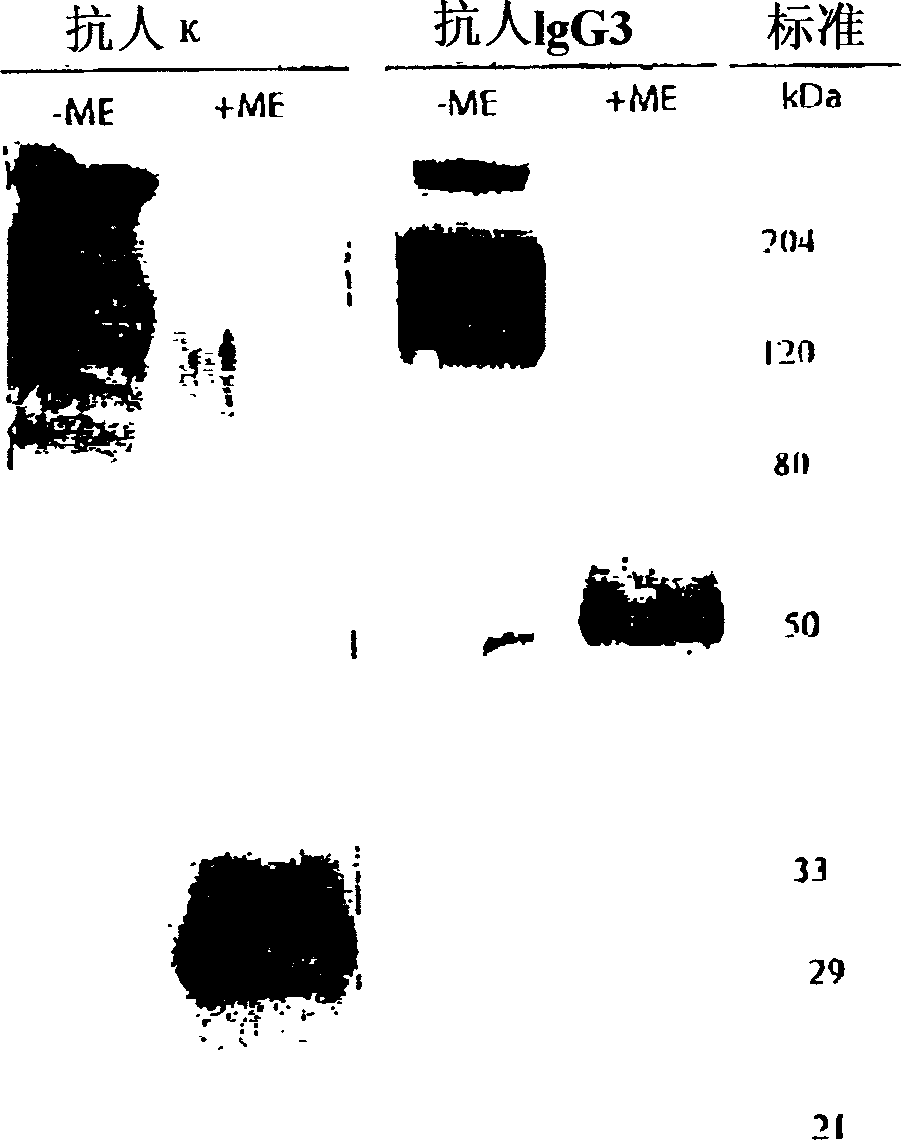Bispecific antibody DNA constructs for intramuscular administration
A technology of antibodies and vectors, applied in the direction of recombinant DNA technology, antibodies, DNA / RNA vaccination, etc., can solve the problems of low transfer efficiency, weeks or months, etc.
- Summary
- Abstract
- Description
- Claims
- Application Information
AI Technical Summary
Problems solved by technology
Method used
Image
Examples
Embodiment 1
[0064] Example 1: Serum expression specific for I-E following electroporation of expression vectors in muscle cells d or IgD a chimeric human / mouse antibody
[0065] This example shows that injection of expression vectors, in this case encoding antibody heavy and light chains, into skeletal muscle results in the production of intact complete antibodies and release of the antibodies into the individual's circulatory system. Intramuscular injection of a mixture of vectors, each encoding either the heavy or light chain of the antibody, or one vector encoding both chains, followed by electroporation at the injection site, followed by an assay designed to assess the full-length Antibody expression. In this regard, three expression vectors were prepared, a heavy chain vector constructed to contain DNA encoding a chimeric heavy chain IgG3 (murine V gene and human C gene), and a light chain vector constructed to contain DNA encoding a chimeric human IgG3 Kappa light chain (mouse V ...
Embodiment 2
[0098] Example 2: Removing heterogeneous sequences can enable long-term expression of antibodies in serum in vivo
[0099] Removal of heterologous sequences from expressed mAbs determines whether reduced immunogenicity increases the amount or duration of recombinant antibody expression in serum. In the first experiment, chimeric IgD a Antibody (in this antibody, V H Derived from Ig(5a)7.2, while C H A heavy chain vector derived from the human γ3 chain) was modified to remove the human γ3 constant region and replace it with the mouse γ2b constant region. The resulting vector pLNOH2γ2bV H T (Lunde et al., supra, 1999) with the variable region of Ig(5a)7.2, and the corresponding human / mouse chimeric light chain vector (pLNO κ V L T; Lunde et al., supra, 1999) co-injected into muscle. The expressed antibody is thus partially chimeric, with a safe mouse heavy chain, and a chimeric human / mouse light chain.
[0100] The serum analysis method is as follows: the NIP 2.6 BSA was...
Embodiment 3
[0105] Example 3: Lysis of cells by antibodies expressed in serum mediated by complement
[0106] The integrity of expressed antibodies is assessed by determining whether serum-expressed antibodies and their antigen binding activate complement. Complement-mediated cell lysis (CML) was performed as described. Michaelsen et al., Scand. J. Immunol. 32, 517-528 (1990); Aase et al., J. Immunol. Methods 136, 185-191. Briefly, by co-cultivating cells with rabbit anti-SRBC NIP-15-Fab' fragments, it was found that 51 CR-labeled sheep red blood cells (SRBC) are sensitive to NIP. According to the present invention, serial dilutions of NIP murine antibodies expressed in serum are added to NIP-sensitive 51 CR SRBC. Human serum was used as a source of complement. The same NIP antibody expressed from recombinant cells as well as purified NIP antibody were used as controls. The cytotoxicity index (CI) was calculated according to the formula: %CI=[(detected cpm-spontaneous cpm) / (maximum ...
PUM
 Login to View More
Login to View More Abstract
Description
Claims
Application Information
 Login to View More
Login to View More - Generate Ideas
- Intellectual Property
- Life Sciences
- Materials
- Tech Scout
- Unparalleled Data Quality
- Higher Quality Content
- 60% Fewer Hallucinations
Browse by: Latest US Patents, China's latest patents, Technical Efficacy Thesaurus, Application Domain, Technology Topic, Popular Technical Reports.
© 2025 PatSnap. All rights reserved.Legal|Privacy policy|Modern Slavery Act Transparency Statement|Sitemap|About US| Contact US: help@patsnap.com



